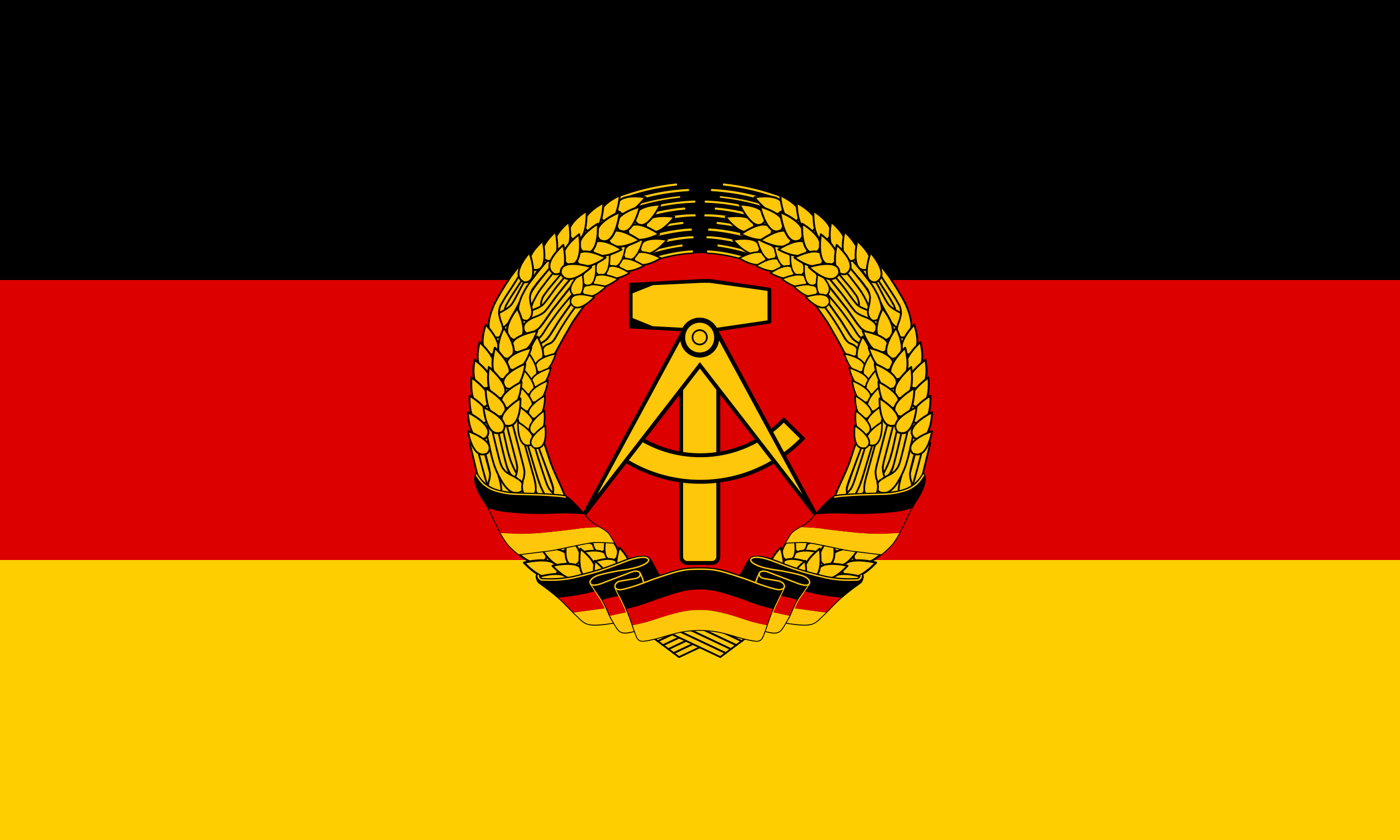More languages
More actions
| German democratic republic Deutsche Demokratische Republik | |
|---|---|
| 1949–1990 | |
|
Flag | |
Motto: Proletarier aller Länder, vereinigt Euch! Workers of the world, unite! | |
Anthem: "Auferstanden aus Ruinen" "Risen from Ruins" | |
| Capital | East Berlin |
| Official languages | German |
| Dominant mode of production | Socialism |
| Government | Federal Marxist-Leninist socialist republic (1949–1952) Unitary Marxist-Leninist socialist republic (1952–1989) Unitary parliamentary republic (1989–1990) |
• 1946–1950 | Wilhelm Pieck and Otto Grotewohl |
• 1950–1971 | Walter Ulbricht |
• 1971–1989 | Erich Honecker |
• 1989 | Egon Krenz |
| Legislature | Volkskammer |
| History | |
• Soviet liberation of Germany | 8 May 1945 |
• Constitution adopted | 7 October 1949 |
• Fall of Anti-Fascist Protection Wall | 9 November 1989 |
• Annexation by West Germany | 3 October 1990 |
| Area | |
• Total | 108,333 km² |
| Population | |
• 1990 census | 16,111,000 |
• Density | 149 km² |
| GDP (PPP) | 1989 estimate |
• Total | $525.29 billion |
• Per capita | $42,004 |
| HDI | 0.953 (1989) |
| Currency | East German mark |
| Driving side | right |
| Calling code | +37 |
| Internet TLD | .dd |
| Today part of | Germany |
The German Democratic Republic (German: Deutsche Demokratische Republik, GDR or DDR), sometimes referred to as East Germany, was a country that existed from 1949 to 1990. In Western media it was referred to as a communist state, but it described itself as a socialist "workers' and peasants' state".[1]
The GDR was formed on 7 October 1949 with the adoption of its first constitution; elections for the Constitutional Assembly were held 5 months earlier, on 15 and 16 May 1949.
The GDR was annexed by the Federal Republic of Germany, also known as West Germany, on 3 October 1990.
Economy
From 1951 to 1989, the GDR's GDP grew at an average rate of 4.5% per year, while West Germany's GDP only grew by 4.3%.[2]
| Year | Monthly wage (DDM)[3] |
|---|---|
| 1950 | 311 |
| 1960 | 555 |
| 1970 | 755 |
| 1985 | 1,130 |
Education
In 1985, there were 13,148 preschools in the DDR attended by children from ages three to six. Attendance was not mandatory but 91% of eligible children participated. Starting at the age of six, there were ten years of mandatory education. In grades seven through ten, 22% of instruction time was spent on science, 15% on math, and 34% on history, language, and literature. English and Russian were also taught as foreign languages. After completing the compulsory ten years of education, students could go to a university or vocational school. There were 54 universities and colleges and 963 vocational schools in the country. College was cheap and many textbooks were available for free.[4]
Women's Rights
80% of women in the GDR between the ages of 18 and 60 were employed. By 1985, half of the university students in the country were female, doubling from a quarter in 1960.[5] By the mid-1980's, birth control pills were also available free of charge.[6]
References
- ↑ Chapter 1, Article 1 of the 1968 Constitution of the German Democratic Republic (1974 amendments) [Text (in German); Archived]
- ↑ Karl Mai (2009). GDR - FRG in an economic-statistical comparison 1950 to 1989 - On new results by Prof. Gerhard Heske (German: DDR – BRD im ökonomisch-statistischen Vergleich 1950 bis 1989 - Zu neuen Ergebnissen von Prof. Gerhard Heske). [PDF]
- ↑ Stephen R. Burrant (1987). East Germany: A Country Study: 'The Economy; The Consumer in the East German Economy' (p. 154). United States Federal Research Division.
- ↑ Stephen R. Burrant (1987). East Germany: A Country Study: 'The Society and Its Environment; The Educational System'. United States Federal Research Division.
- ↑ Stephen R. Burrant (1987). East Germany: A Country Study: 'The Society and Its Environment; Women and the Democratic Women's League of Germany' (p. 102). United States Federal Research Division.
- ↑ Stephen R. Burrant (1987). East Germany: A Country Study: 'The Society and Its Environment; Institutions and Organs of Society' (p. 95). United States Federal Research Division.

